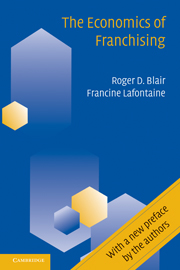Book contents
- Frontmatter
- Contents
- Preface
- 1 Introduction
- 2 Four Popular Misconceptions about Franchising
- 3 Franchise Contracts
- 4 Franchising, Vertical Integration, and Vertical Restraints
- 5 Quality Control
- 6 Franchise Tying Contracts
- 7 Vertical Price Controls in Franchising
- 8 Encroachment
- 9 Advertising and Promotion
- 10 Termination and Non-Renewal
- 11 Concluding Remarks
- Articles, Books, and Other Publications
- Cases, Codes, and Statutes
- Index
2 - Four Popular Misconceptions about Franchising
Published online by Cambridge University Press: 24 May 2010
- Frontmatter
- Contents
- Preface
- 1 Introduction
- 2 Four Popular Misconceptions about Franchising
- 3 Franchise Contracts
- 4 Franchising, Vertical Integration, and Vertical Restraints
- 5 Quality Control
- 6 Franchise Tying Contracts
- 7 Vertical Price Controls in Franchising
- 8 Encroachment
- 9 Advertising and Promotion
- 10 Termination and Non-Renewal
- 11 Concluding Remarks
- Articles, Books, and Other Publications
- Cases, Codes, and Statutes
- Index
Summary
There are many misconceptions surrounding franchising in the United States and abroad. In our view, these misconceptions result from relying on casual impressions rather than a careful evaluation of the empirical evidence. In this chapter, we focus our attention on four such misconceptions. By summarizing the existing data, we hope to disabuse the reader of these misconceptions and thereby generate a more realistic appreciation of franchising.
We begin with the notion that franchising has been growing at a phenomenal rate in the U.S. for several decades. As we shall show, this impression is misleading: for the last two decades at least, our best estimates indicate that franchising in the U.S. has grown, at most, at rates commensurate with the rest of the economy. Interestingly, research conducted in the United Kingdom suggests that similar claims of tremendous growth in franchising in that country in the 1990s are also ill-founded. Second, we examine the extent of entry and exit for franchisors, and then also for franchisees. The data show that many firms indeed become new franchisors each year, a fact that is well-publicized in the trade press. But many firms also exit franchising or fail, and this generally receives much less attention. As for franchisees, we find that the notion that franchising poses substantially fewer business risks for franchisees than starting an independent business is not supported by the data. Third, we consider the size of franchised chains.
- Type
- Chapter
- Information
- The Economics of Franchising , pp. 20 - 53Publisher: Cambridge University PressPrint publication year: 2005



